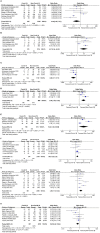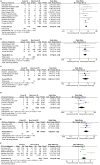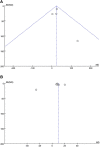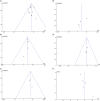Comparison of the Characteristics, Management, and Outcomes of STEMI Patients Presenting With vs. Those of Patients Presenting Without COVID-19 Infection: A Systematic Review and Meta-Analysis
- PMID: 35360030
- PMCID: PMC8964144
- DOI: 10.3389/fcvm.2022.831143
Comparison of the Characteristics, Management, and Outcomes of STEMI Patients Presenting With vs. Those of Patients Presenting Without COVID-19 Infection: A Systematic Review and Meta-Analysis
Abstract
Objectives: This study aimed to investigate the differences in the characteristics, management, and clinical outcomes of patients with and that of those without coronavirus disease 2019 (COVID-19) infection who had ST-segment elevation myocardial infarction (STEMI).
Methods: Databases including Web of Science, PubMed, Cochrane Library, and Embase were searched up to July 2021. Observational studies that reported on the characteristics, management, or clinical outcomes and those published as full-text articles were included. The Newcastle-Ottawa Scale (NOS) was used to assess the quality of all included studies.
Results: A total of 27,742 patients from 13 studies were included in this meta-analysis. Significant delay in symptom onset to first medical contact (SO-to-FMC) time (mean difference = 23.42 min; 95% CI: 5.85-40.99 min; p = 0.009) and door-to-balloon (D2B) time (mean difference = 12.27 min; 95% CI: 5.77-18.78 min; p = 0.0002) was observed in COVID-19 patients. Compared to COVID-19 negative patients, those who are positive patients had significantly higher levels of C-reactive protein, D-dimer, and thrombus grade (p < 0.05) and showed more frequent use of thrombus aspiration and glycoprotein IIbIIIa (Gp2b3a) inhibitor (p < 0.05). COVID-19 positive patients also had higher rates of in-hospital mortality (OR = 5.98, 95% CI: 4.78-7.48, p < 0.0001), cardiogenic shock (OR = 2.75, 95% CI: 2.02-3.76, p < 0.0001), and stent thrombosis (OR = 5.65, 95% CI: 2.41-13.23, p < 0.0001). They were also more likely to be admitted to the intensive care unit (ICU) (OR = 4.26, 95% CI: 2.51-7.22, p < 0.0001) and had a longer length of stay (mean difference = 4.63 days; 95% CI: 2.56-6.69 days; p < 0.0001).
Conclusions: This study revealed that COVID-19 infection had an impact on the time of initial medical intervention for patients with STEMI after symptom onset and showed that COVID-19 patients with STEMI were more likely to have thrombosis and had poorer outcomes.
Keywords: COVID-19; SARS-CoV-2; ST-segment elevation myocardial infarction; STEMI; mortality.
Copyright © 2022 Wang, Kang, Chien, Xu, You, Xing and Tung.
Conflict of interest statement
The authors declare that the research was conducted in the absence of any commercial or financial relationships that could be construed as a potential conflict of interest.
Figures









Similar articles
-
[Evidence-based management of ST-segment elevation myocardial infarction (STEMI). Latest guidelines of the European Society of Cardiology (ESC) 2010].Herz. 2010 Dec;35(8):558-64. doi: 10.1007/s00059-010-3401-8. Herz. 2010. PMID: 21107514 German.
-
In-hospital mortality of COVID-19 patients hospitalized with ST-segment elevation myocardial infarction: A meta-analysis.Int J Cardiol Heart Vasc. 2022 Nov 17;43:101151. doi: 10.1016/j.ijcha.2022.101151. eCollection 2022 Dec. Int J Cardiol Heart Vasc. 2022. PMID: 36411872 Free PMC article.
-
Association of Thrombus Aspiration With Time and Mortality Among Patients With ST-Segment Elevation Myocardial Infarction: A Post Hoc Analysis of the Randomized TOTAL Trial.JAMA Netw Open. 2021 Mar 1;4(3):e213505. doi: 10.1001/jamanetworkopen.2021.3505. JAMA Netw Open. 2021. PMID: 33769510 Free PMC article. Clinical Trial.
-
Outcomes of STEMI Patients in COVID-19 Pandemic: A Systematic Review and Meta-Analysis.Iran J Public Health. 2024 Sep;53(9):1964-1975. doi: 10.18502/ijph.v53i9.16451. Iran J Public Health. 2024. PMID: 39429670 Free PMC article. Review.
-
The Impact of the Early COVID-19 Pandemic on ST-Segment Elevation Myocardial Infarction Presentation and Outcomes-A Systematic Review and Meta-Analysis.Diagnostics (Basel). 2022 Feb 25;12(3):588. doi: 10.3390/diagnostics12030588. Diagnostics (Basel). 2022. PMID: 35328141 Free PMC article. Review.
Cited by
-
Differences in door-to-balloon time and outcomes in SARS-CoV-2-positive ST-segment elevation myocardial infarction patients undergoing primary percutaneous coronary intervention: A systematic review and meta-analysis.Medicine (Baltimore). 2023 Oct 13;102(41):e35612. doi: 10.1097/MD.0000000000035612. Medicine (Baltimore). 2023. PMID: 37832042 Free PMC article.
-
The effect of COVID-19 on the in-hospital outcomes of percutaneous coronary intervention in patients with acute coronary syndrome: A large scale meta-analysis.Am J Med Open. 2023 Jun;9:100032. doi: 10.1016/j.ajmo.2023.100032. Epub 2023 Jan 18. Am J Med Open. 2023. PMID: 36685608 Free PMC article.
-
Restenosis of Coronary Arteries in Patients with Coronavirus Infection: Case Series.Case Rep Med. 2023 Feb 9;2023:3000420. doi: 10.1155/2023/3000420. eCollection 2023. Case Rep Med. 2023. PMID: 36818597 Free PMC article.
-
Impact of concomitant COVID-19 on the outcome of patients with acute myocardial infarction undergoing coronary artery angiography.Front Cardiovasc Med. 2022 Sep 22;9:917250. doi: 10.3389/fcvm.2022.917250. eCollection 2022. Front Cardiovasc Med. 2022. PMID: 36211554 Free PMC article.
References
-
- Mahmud E, Dauerman HL, Welt FGP, Messenger JC, Rao SV, Grines C, et al. . Management of Acute myocardial infarction during the COVID-19 pandemic: a position statement from the society for cardiovascular angiography and interventions (SCAI), the American college of cardiology (acc), and the American college of emergency physicians (ACEP). J Am Coll Cardiol. (2020) 76:1375–84. 10.1016/j.jacc.2020.04.039 - DOI - PMC - PubMed
Publication types
LinkOut - more resources
Full Text Sources
Research Materials
Miscellaneous

